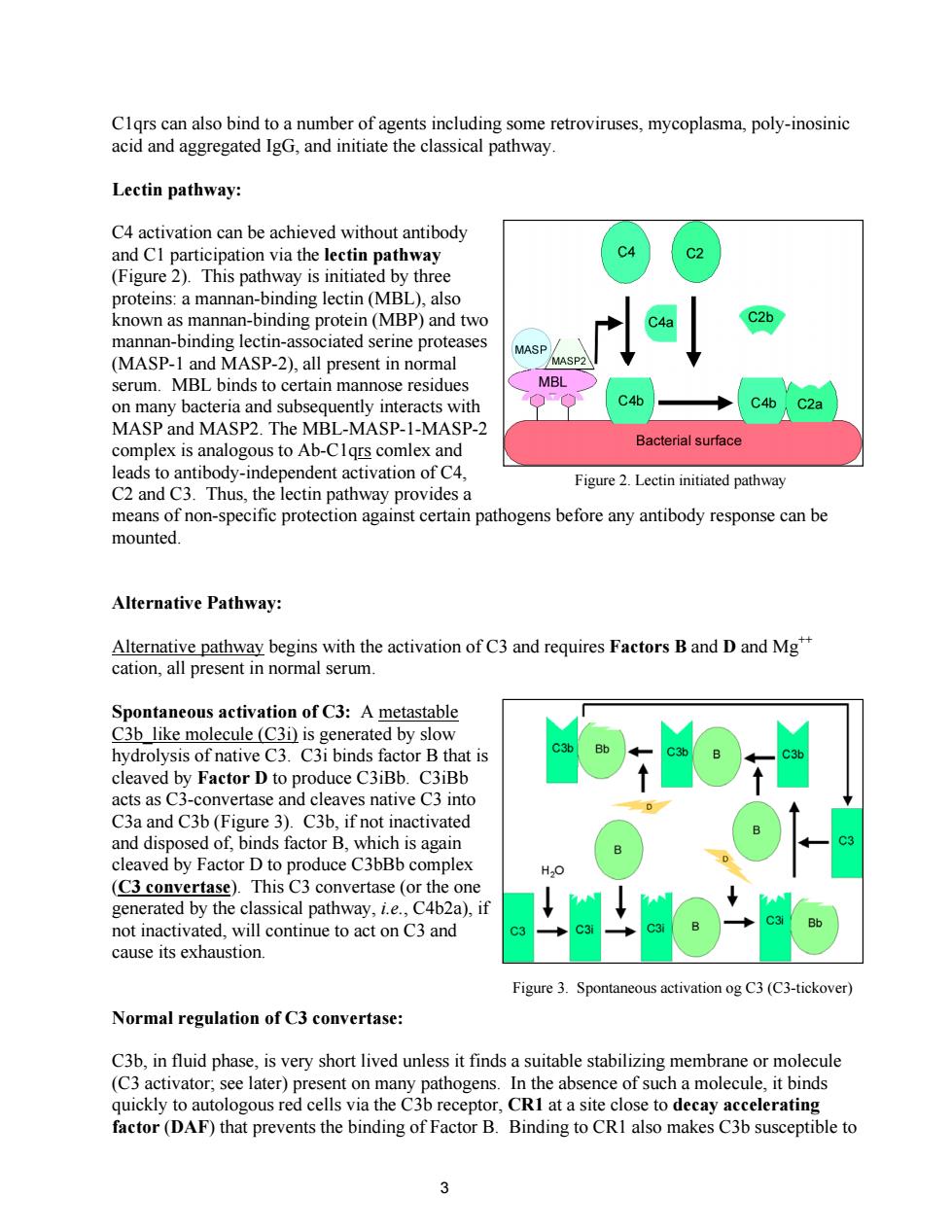正在加载图片...

Clgrs can also bind to a number of agents including some retroviruses,mycoplasma,poly-inosinic acid and aggregated IgG,and initiate the classical pathway. Lectin pathway: C4 activation can be achieved without antibody and Cu proteins:a mannan-binding lectin(MBI also known as mannan-binding protein(MBP)and two C4a mannan-binding lectin-associated serine proteases MASP (MASP-1 and MASP-2),all present in normal serum.MBL binds to certain mannose residues on many bacteria and subsequently interacts with C4b MASP and MASP2.The MBL-MASP-1-MASP-2 Bacterial surface complex is analogous to ab-Clars comlex and leads to antibody-independent activation of C4. C2 and C3.Thus.the lectir Figure 2.Lectin initiated pathway pathway provides means of non-spec ific prote ection agains certa athogens before any antibody response can be mounted. Alternative Pathway: Alternative pathway begins with the activation of C3 and requires Factors B and D and Mg cation,all present in normal serum. Spontaneous activation of C3:A metastable C3b like molecule (C3i)is generated by slow hydrolysis of native C3.C3i binds factor B that is aved b C3iBt acts as nverta native C3 C3a and C3b(Figure 3).C3b,if not inactivated and disposed of,binds factor B,whi h is again cleaved by Factor D to produce C3bBb complex (C3 convertase).This C3 convertase(or the one generated by the classical pathway,ie.,C4b2a),if not inactivated,will continue to act on C3 and cause its exhaustion. Figure 3.Spontaneous activation og C3(C3-tickover) Normal regulation of C3 convertase: C3b,in fluid phase,is very short lived unless it finds a suitable stabilizing membrane or molecule C3activator see later)present many pathogens. In the absence of such a molecule,it binds quickly to autologous red cells via the C3b receptor,CRI at a site close to decay accelerating factor(DAF)that prevents the binding of Factor B.Binding to CRI also makes C3b susceptible to 3C1qrs can also bind to a number of agents including some retroviruses, mycoplasma, poly-inosinic acid and aggregated IgG, and initiate the classical pathway. Lectin pathway: C4 activation can be achieved without antibody and C1 participation via the lectin pathway (Figure 2). This pathway is initiated by three proteins: a mannan-binding lectin (MBL), also known as mannan-binding protein (MBP) and two mannan-binding lectin-associated serine proteases (MASP-1 and MASP-2), all present in normal serum. MBL binds to certain mannose residues on many bacteria and subsequently interacts with MASP and MASP2. The MBL-MASP-1-MASP-2 complex is analogous to Ab-C1qrs comlex and leads to antibody-independent activation of C4, C2 and C3. Thus, the lectin pathway provides a means of non-specific protection against certain pathogens before any antibody response can be mounted. Figure 2. Lectin initiated pathway Alternative Pathway: Alternative pathway begins with the activation of C3 and requires Factors B and D and Mg++ cation, all present in normal serum. Figure 3. Spontaneous activation og C3 (C3-tickover) Spontaneous activation of C3: A metastable C3b_like molecule (C3i) is generated by slow hydrolysis of native C3. C3i binds factor B that is cleaved by Factor D to produce C3iBb. C3iBb acts as C3-convertase and cleaves native C3 into C3a and C3b (Figure 3). C3b, if not inactivated and disposed of, binds factor B, which is again cleaved by Factor D to produce C3bBb complex (C3 convertase). This C3 convertase (or the one generated by the classical pathway, i.e., C4b2a), if not inactivated, will continue to act on C3 and cause its exhaustion. Normal regulation of C3 convertase: C3b, in fluid phase, is very short lived unless it finds a suitable stabilizing membrane or molecule (C3 activator; see later) present on many pathogens. In the absence of such a molecule, it binds quickly to autologous red cells via the C3b receptor, CR1 at a site close to decay accelerating factor (DAF) that prevents the binding of Factor B. Binding to CR1 also makes C3b susceptible to 3